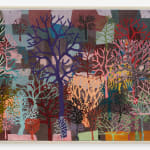-
Artworks
Color Flash for Chat and Chew, Paris Texas in Seventy-Two, (Winter), 2020
silk and wool60 x 132 in.
152.4 x 335.3 cmEdition of 2 plus 1 artist's proofFurther images
-
(View a larger image of thumbnail 1
)

-
(View a larger image of thumbnail 2
)

-
(View a larger image of thumbnail 3
)

-
(View a larger image of thumbnail 4
)

-
(View a larger image of thumbnail 5
)

-
(View a larger image of thumbnail 6
)

-
(View a larger image of thumbnail 7
)

-
(View a larger image of thumbnail 8
)

-
(View a larger image of thumbnail 9
)

The Museum of Fine Arts, Houston, has commissioned Trenton Doyle Hancock to create 'Color Flash for Chat and Chew, Paris Texas in Seventy-Two,' a 10 by 24 foot hand-woven tapestry permanently installed...The Museum of Fine Arts, Houston, has commissioned Trenton Doyle Hancock to create "Color Flash for Chat and Chew, Paris Texas in Seventy-Two," a 10 by 24 foot hand-woven tapestry permanently installed in the Museum's new Kinder Building.
"Color Flash for Chat and Chew, Paris Texas in Seventy-Two, (Winter)" and "Color Flash for Chat and Chew, Paris Texas in Seventy-Two, (Fall)" are seasonal variations of this monumental tapestry commission. They intermingle Hancock's personal history with the fantastical narrative of his Moundverse. Each tapestry depicts vividly colored trees across an abstract field. The tonal changes between the two works reflects the changing seasons of their respective titles.
The woven trees are modeled on the deciduous oaks that grew in a wooded area outside Hancock’s childhood home in Paris, Texas where he often played as a child. For Hancock, this woodland space is a place of becoming and discovery, full of an almost fairytale-like potential for the realization of the impossible and improbable. The forest also holds special significance within Hancock’s invented Moundverse: it is the home of Mound #1, the Legend, a half-human, half-tree mutant. The oldest of the Mounds, he is the center of the artist’s painted universe and exudes an air of hope, representing long-standing ideals. He lives in the forest and his skeleton is shaped like a tree. A color flash is the way that a Mound dreams. Thus, viewers of the work are both seeing a Mound dream, and seeing the world through the eyes of a Mound.
The title of the work also alludes to artistic origin stories. Chat and Chew was a club started by Hancock’s Great Aunt Fan Fan, which gave her a chance to get together with neighbors and gossip. Aunt Fan Fan taught Trenton to draw as a child, encouraging his nascent artistic impulses.
These tapestries rearticulate the visual language Hancock first explored in 2004 and 2005 in his Good Vegan Progression felt and mixed media collages. This imagery later appeared in the artist's Good Vegan Progression #5, which was produced with the Fabric Workshop and Museum in Philadelphia, where he was artist-in-residence, and served as a backdrop for the 2008 Ballet Austin collaborative production of "Cult of Color: Call to Color."
All three tapestries were hand-woven by the Jains, a multigenerational family of weavers, in the village of Parsipur in Uttar Pradesh India and produced by Odabachian. -
(View a larger image of thumbnail 1
)







